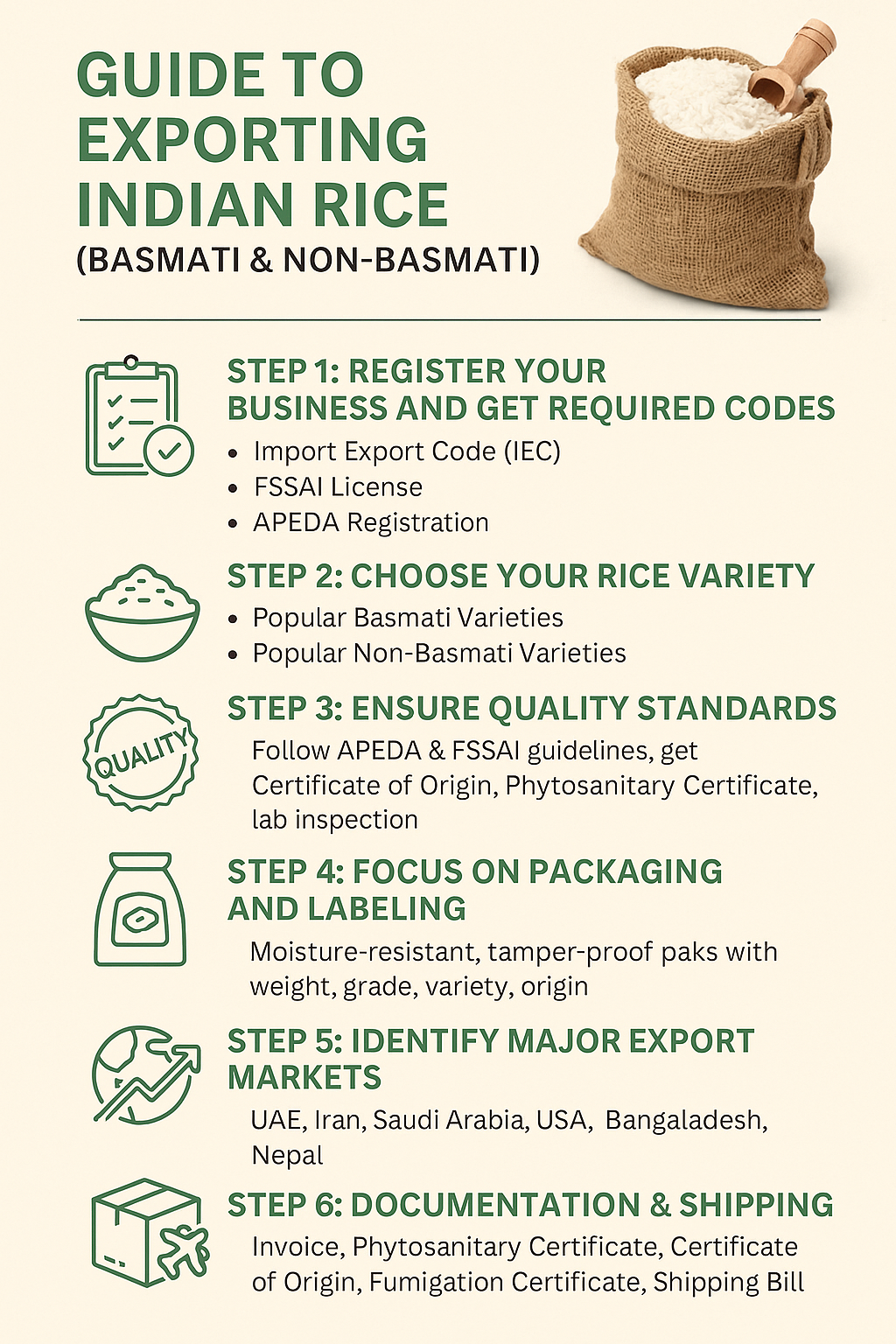Guide to Exporting Indian Rice (Basmati & Non-Basmati)
India is the world’s largest exporter of rice, commanding over 40% of global trade. Indian rice — especially Basmati and Non-Basmati varieties — is in high demand across Asia, the Middle East, Europe, and Africa. If you’re looking to tap into this thriving opportunity, here’s your step-by-step guide to export rice from India.

🔹 Step 1: Register Your Business and Get Required Codes
Start by ensuring all legal registrations are in place:
- Import Export Code (IEC) – obtained via DGFT
- FSSAI License – mandatory for food products
- APEDA Registration – compulsory for rice exporters under the Agri Export Policy
👉 APEDA provides technical guidance, financial assistance, and access to global buyer networks.
🔹 Step 2: Choose Your Rice Variety
Popular Indian Basmati Varieties:
- 1121 Basmati
- Pusa Basmati
- Traditional Basmati
- Sugandha & Sharbati (light aroma)
Popular Non-Basmati Varieties:
- Sona Masoori
- IR64
- Ponni Rice
- Parboiled Rice
📦 Tip: Match your rice variety with demand in specific countries (e.g., 1121 Basmati is popular in UAE and Iran, while IR64 is in demand across Africa).
🔹 Step 3: Ensure Quality Standards and Testing
To succeed in rice exports, quality control is key. Follow:
- APEDA & FSSAI guidelines for permissible moisture levels, broken grain %, pesticide residue, etc.
- Use Govt. approved laboratories for inspection and testing
- Obtain Certificate of Origin and Phytosanitary Certificate
🌾 For Basmati, ensure GI tag compliance and aromatic purity.
🔹 Step 4: Focus on Packaging and Labeling
Export packaging must:
- Be moisture-resistant and tamper-proof
- Mention:
- Type of rice (Basmati/Non-Basmati)
- Grade and variety
- Country of Origin: India
- Batch No, Weight, Manufacturer
- Prefer 5kg, 10kg, and 25kg export-friendly packs (vacuum or laminated)
🔹 Step 5: Identify Major Export Markets
Top Importing Countries:
| Country | Preference |
|---|---|
| Iran | 1121 Basmati, Traditional |
| Saudi Arabia | Pusa Basmati, Parboiled |
| UAE | Basmati, Sona Masoori |
| USA | Organic Basmati |
| Bangladesh & Nepal | Non-Basmati (IR64) |
🛒 Use platforms like Tridge, Alibaba, Indiamart, APEDA Buyer-Seller Meet for lead generation.
🔹 Step 6: Documentation & Shipping
Mandatory export documents:
- Commercial Invoice & Packing List
- Phytosanitary Certificate
- Certificate of Origin (CoO)
- Shipping Bill
- Fumigation Certificate (if required)
- Letter of Credit or Bank Contract Copy
🚢 Tip: Ship via port-based rice hubs like Mundra, Kandla, or Kolkata for faster access to foreign markets.
✅ Conclusion
With the right paperwork, quality control, and buyer connections, exporting Indian rice can be a high-volume, high-reward venture. Whether you’re starting with Basmati or Non-Basmati, this sector offers massive global potential.
👉 Want to master export pricing step-by-step, including Incoterms, margin, freight, and refunds?
📘 Grab our ₹299 beginner-friendly guide:
Start Exporting from India in Just 30 Days
Visit 👉 StartExportIndia.com



